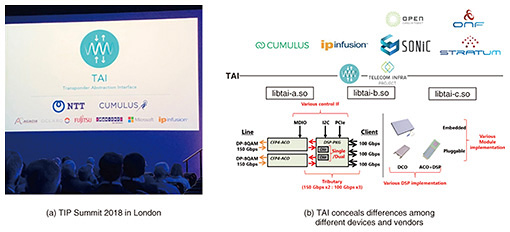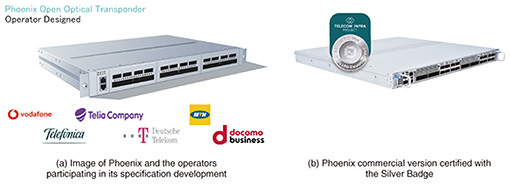 |
|||||||||||||||||||||||
|
|
|||||||||||||||||||||||
|
Global Standardization Activities Vol. 22, No. 7, pp. 61–66, July 2024. https://doi.org/10.53829/ntr202407gls2 Latest Trends in Open Optical Transmission Equipment in TIP OOPTAbstractThe Telecom Infra Project Open Optical & Packet Transport (TIP OOPT) carries out activities aimed at decoupling hardware and software and accelerating innovation in optical and IP networks. This article focuses on the TIP Phoenix Project, in which operators are working together to present common use cases and specifications to encourage the entry of new vendors and reduce costs. The background of the project, efforts to date, and contribution of the NTT Group are explained. Keywords: TIP OOPT, network operating system (NOS), optical transmission equipment 1. Background to the establishment of TIP OOPTNew technologies to separate hardware and software are being implemented in datacenters to efficiently handle the rapidly increasing traffic for social network services and image distribution services. In particular, server virtualization technology, in which a single piece of high-performance hardware is partitioned and used efficiently by virtualization, and storage virtualization technology, in which multiple pieces of server hardware are treated as a single computer to improve capacity and fault tolerance, have emerged. These virtualization technologies enable datacenter operators to not only reduce costs through efficiency but also build systems in a short period (speed and agility) and expand system reliably (redundancy) and flexibly. In 2011, the Open Compute Project (OCP) was established to verify and openly share system specifications of datacenter facility elements (servers, air conditioning, power, etc.) that enable high efficiency. Hyperscalers, such as Facebook (now Meta) and Microsoft, and whitebox vendors are entering and expanding the market for these elements. In 2016, the Telecom Infra Project (TIP) was established with the aim of enabling companies to cooperate and create new technologies for constructing and developing telecommunication network infrastructures in emerging and developed countries. While OCP covers the inside of the datacenter, TIP targets the outside of the datacenter. The latter has established project groups, such as Open RAN, which develop and build radio access network (RAN) solutions from second-generation mobile communications system (2G) to 5G based on general-purpose, vendor-neutral hardware, open interfaces, and software, and Open Optical & Packet Transport (OOPT), which aims to decouple hardware and software and accelerate innovation in optical and Internet protocol (IP) networks. The challenges faced by OOPT operators in the vertical integration market are illustrated in Fig. 1(a). When an operator procures and installs optical transmission equipment from Vendor A and Vendor B, since each vendor has different equipment interfaces and operations (performance monitor, file update, version upgrade, etc.), the operator must separately conduct operating-system development and engineer training for equipment A and equipment B. When the business model is based on vertical integration, there is less flexibility in procurement, prices tend to remain high, and the time from ordering to delivery is long (about a year in the case of optical transmission equipment). To solve this problem, OOPT carries out activities in the six subgroups shown in Fig. 1(b); Metaverse Ready Architectures for Transport Networks (MANTRA), Mandatory Use Case Requirements For SDN Transport (MUST), Networking Operating Systems (OOPT-NOS), Disaggregated Open Routers (DOR), Physical Simulation Environment (PSE), and Disaggregated Optical Systems (DOS). This article introduces OOPT-NOS and DOS, which are most closely related to the disaggregated 400G transponder “Phoenix.”
2. OOPT-NOSThe mission of this group is to (1) define the specifications, architecture, and reference implementation of Goldstone, an open and disaggregated network operating system (NOS) for optical transmission equipment, and (2) promote openness and bring Goldstone to the market through commercial implementation by equipment vendors. Goldstone implements various functions on a device as containers, making it easy for vendors and operators to add or modify functions. Thus far, NTT R&D laboratories have developed: (1) a function to enable device control using standard control interfaces, such as OpenROADM [1] and OpenConfig [2], for specification development, (2) a function to enable control by standard communication protocols, such as gNMI [3] as well as NETCONF, and (3) a streaming telemetry function to collect various information on a device, for Phoenix, a piece of open optical transmission equipment. NTT developed these functions in collaboration with partners including NEC and Fujitsu and contributed to the uptake of Phoenix in collaboration with worldwide operators [4, 5]. NTT also worked with IP Infusion (IPI) to implement functions to support CSR320, a disaggregated cell site gateway (DCSG), and the aggregation router AGR400 as well as contributed to their content. NTT’s partner, NEC, commercialized NEC NOS on the basis of Goldstone NOS together with Phoenix, which is described later, and in October 2023, received a Silver Badge [6] from TIP, which proves that it has passed verification of more than 100 items by network operators. The group will continue to study and promote openness of platforms for switchponders that can use optical transmission functions by inserting pluggable coherent modules into router switches, such as DCSG and AGR400. 3. DOSThe mission of this group is to define specifications for open and disaggregated optical transmission equipment and bring such equipment to market. Separating hardware and software makes it easier to adapt to changing service requirements by enabling quick, individual application of the latest technologies and continuous improvement of performance. This article introduces the Cassini open packet/optical transponder, which is a representative DOS achievement, and the Transponder Abstraction Interface (TAI), an open interface for optical transmission that hides the differences among different devices and vendors and complex register access. The conventional transmission-equipment market has formed a vertically integrated business model in which system vendors that manufacture mainboards and implement line cards of their own specifications work closely with transceiver vendors that manufacture and supply line cards to these systems to pursue high transmission performance (Fig. 2(a)). However, the software to be implemented on the device is distributed on the mainboard and on the line cards, and the interfaces are different for each vendor and method, making it unsuitable for separating hardware and software. DOS, in cooperation with Edgecore, the world’s top market shareholder in the whitebox switch market, applied a whitebox switch architecture that separates hardware and software (Fig. 2(b)) to optical transmission equipment to create Cassini, which integrates 100GbE switching and Layer 1 optical transport functions into a single enclosure as a line card module compatible with multi-vendor, multi-generation coherent transceivers (Fig. 2(c)). Since this required an open interface to hide the differences among devices and vendors and complex register access, the NTT Group and Cumulus Networks (now NVIDIA) took the lead and cooperated with hyperscalers and major component suppliers such as NTT Electronics (now NTT Innovative Devices) and Acacia to develop the TAI [7]. Figure 3(a) is a photo during the TIP Summit held in 2018, and Figure 3(b) shows an image of how the TAI conceals differences among devices and vendors and complex register access to enable control and management from various NOSs using common source code. IPI has implemented the TAI on OcNOS, its commercial OS, applied it to Cassini, and commercially introduced it in Burkina Faso in Africa, Chile, Pakistan, and other countries [8].
4. Disaggregated 400G transponder “Phoenix”At the TIP Summit in 2018, Telefonica announced plans for a disaggregated 400G transponder. In anticipation of the uptake of 400-Gbit/s pluggable coherent transceivers, the company announced its goal to develop equipment that separate hardware and software, not only for switchponders such as Cassini, but also for transponders and muxponders, which are Layer 1 devices widely used by carriers to convert optical and electrical signals. It also aims to reduce costs through carrier collaborations to present common use cases and specifications to encourage new entrants to the market. The project, later named Phoenix, published its technical specifications in December 2019, and in April 2020, a joint request for information (RFI) by Vodafone, Telefonica, Telia Company, NTT Communications, DT, and MTN was issued (Fig. 4(a)). After the RFI was issued, operators participating in DOS received a total of ten proposals for hardware, software, and total solutions. For each proposal, product explanations from the vendor, operator team discussions from a technical perspective, and discussions between the operator and vendor were conducted. Verification using actual equipment was carried out, and in June 2022, recommended requirements were established for the community and released as a detailed technical requirement document (dTRD). The dTRD consolidates about 200 detailed technical specifications for Phoenix in terms of physical requirements, optical transmission standards, control, monitoring operation, openness, etc. In regard to openness, the dTRD included the TAI’s interface support mechanism for hardware and software separation, which is a distinct feature of Phoenix. After the release of the dTRD, applications for Phoenix Badge certification (whether the dTRD specifications are met) were solicited. Galileo FlexT and NEC NOS obtained Silver Badge certification (whether specifications are met on prototype verification) in October 2023. NEC NOS, based on the aforementioned Goldstone NOS, became the first in the world to obtain Phoenix Silver Badge certification (Fig. 4(b)). Gold Badge certification (whether specifications are met on commercial-level environment) will also be conducted in the future.
The NTT Group worked with operators such as Telia, Vodafone, DT, and Telefonica to prepare the RFI, dTRD, test plans, and other documents, carried out discussions and verifications with vendors, and conducted badge certification evaluations. In the preparation of the dTRD, NTT was in charge of 40 out of about 200 items and contributed to the review and prioritization of all the items. In the Silver Badge certification process for NEC NOS in 2023, MTN and NTT Communications divided more than 100 operator tests and conducted tests with respective vendors in validation environments in South Africa and Japan, respectively. On the basis of the test results, badge certification was obtained as a community. In the TIP community, granting a badge to a vendor product is an acknowledgment that the product meets the specified functionality and quality level of the relevant badge. The badge system allows vendors to promote their products in the community by being certified, thus increasing the market value of their products. Operators can refer to the badge specification when selecting products, partially simplifying the conventional RFP formulation and response evaluation processes and making it possible to omit the contents included in the badge for product introduction tests. Edgecore and Pegatron have newly joined the Phoenix hardware market as suppliers, further expanding the market for open optical transmission equipment. 5. Future prospectsThe IOWN Global Forum has developed the Innovative Optical and Wireless Network (IOWN) All-Photonics Network (APN) architecture that enables the optical wavelength path, which has thus far been used mainly between facilities of telecommunication carriers, to reach user sites, such as datacenters and medical facilities, as endpoints [9]. We will continue to promote the spread of open optical transmission equipment through the activities of TIP OOPT. By incorporating such optical transmission equipment in the Open APN*1 and Cognitive Foundation*2 architectures defined by the IOWN Global Forum, we will aim to provide new services that enable system construction in a short period and highly reliable and flexible system expansion.
References
|
|||||||||||||||||||||||
















